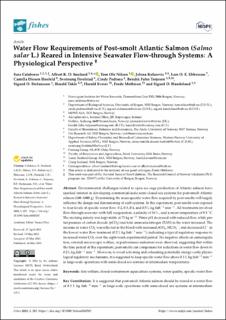Water Flow Requirements of Post-smolt Atlantic Salmon (Salmo salar L.) Reared in Intensive Seawater Flow-through Systems: A Physiological Perspective
| dc.contributor.author | Calabrese, Sara | |
| dc.contributor.author | Imsland, Albert K. D. | |
| dc.contributor.author | Nilsen, Tom Ole | |
| dc.contributor.author | Kolarevic, Jelena | |
| dc.contributor.author | Ebbesson, Lars O.E. | |
| dc.contributor.author | Hosfeld, Camilla Diesen | |
| dc.contributor.author | Fivelstad, Sveinung | |
| dc.contributor.author | Pedrosa, Cindy | |
| dc.contributor.author | Terjesen, Bendik Fyhn | |
| dc.contributor.author | Stefansson, Sigurd O. | |
| dc.contributor.author | Takle, Harald Rune | |
| dc.contributor.author | Sveier, Harald | |
| dc.contributor.author | Mathisen, Frode | |
| dc.contributor.author | Handeland, Sigurd Olav | |
| dc.date.accessioned | 2023-08-08T12:24:40Z | |
| dc.date.available | 2023-08-08T12:24:40Z | |
| dc.date.created | 2023-07-24T15:16:44Z | |
| dc.date.issued | 2023 | |
| dc.identifier.citation | Fishes. 2023, 8 (6), . | |
| dc.identifier.issn | 2410-3888 | |
| dc.identifier.uri | https://hdl.handle.net/11250/3083053 | |
| dc.description.abstract | Environmental challenges related to open sea cage production of Atlantic salmon have sparked interest in developing commercial-scale semi-closed sea systems for post-smolt Atlantic salmon (100–1000 g). Determining the mass-specific water flow required by post-smolts will largely influence the design and dimensioning of such systems. In this experiment, post-smolts were exposed to four levels of specific water flow: 0.2, 0.3, 0.4, and 0.5 L kg fish−1 min−1. All treatments involved flow-through seawater with full oxygenation, a salinity of 34‰, and a mean temperature of 9.3 °C. The stocking density was kept stable at 75 kg m−3. Water pH decreased with reduced flow, while partial pressure of carbon dioxide (pCO2) and total ammonia nitrogen (TAN) in the water increased. The increase in water CO2 was reflected in the blood with increased pCO2, HCO3−, and decreased Cl− in the lowest water flow treatment (0.2 L kg fish−1 min−1), indicating a typical regulatory response to increased water CO2 over the eight-week experimental period. No negative effects on osmoregulation, external macroscopic welfare, or performance indicators were observed, suggesting that within the time period of this experiment, post-smolts can compensate for reductions in water flow down to 0.2 L kg fish−1 min−1. However, to avoid activating and exhausting potentially energy-costly physiological regulatory mechanisms, it is suggested to keep specific water flow above 0.3 L kg fish−1 min−1 in large-scale operations with semi-closed sea systems at intermediate temperatures. | |
| dc.language.iso | eng | |
| dc.title | Water Flow Requirements of Post-smolt Atlantic Salmon (Salmo salar L.) Reared in Intensive Seawater Flow-through Systems: A Physiological Perspective | |
| dc.title.alternative | Water Flow Requirements of Post-smolt Atlantic Salmon (Salmo salar L.) Reared in Intensive Seawater Flow-through Systems: A Physiological Perspective | |
| dc.type | Peer reviewed | |
| dc.type | Journal article | |
| dc.description.version | publishedVersion | |
| dc.source.pagenumber | 16 | |
| dc.source.volume | 8 | |
| dc.source.journal | Fishes | |
| dc.source.issue | 6 | |
| dc.identifier.doi | 10.3390/fishes8060285 | |
| dc.identifier.cristin | 2163281 | |
| cristin.ispublished | true | |
| cristin.fulltext | original | |
| cristin.qualitycode | 1 |
Tilhørende fil(er)
Denne innførselen finnes i følgende samling(er)
-
Artikler / Articles [1429]
-
Publikasjoner fra CRIStin [2493]
